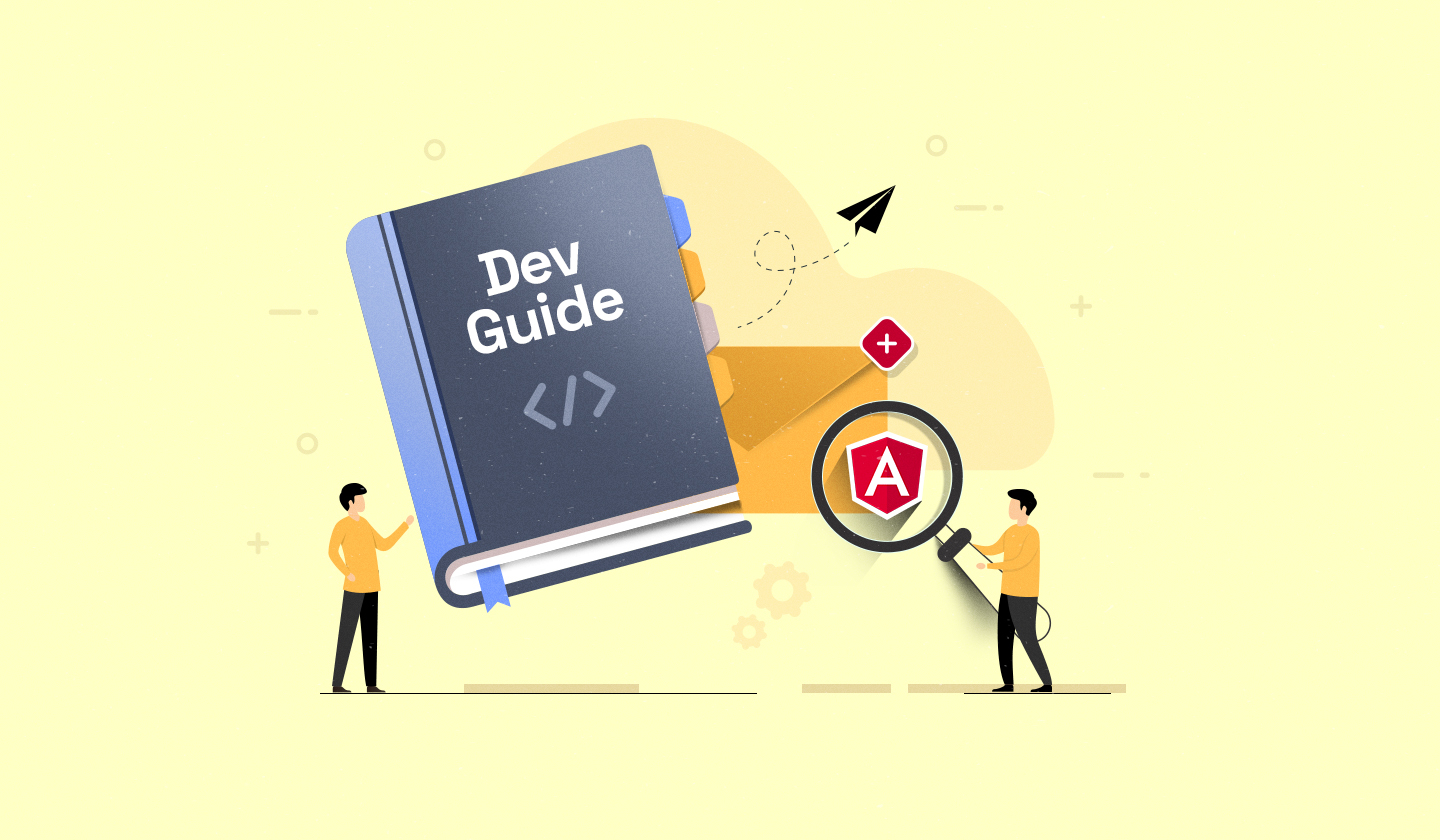Your Angular app is stable, scalable, and doing great in production — until users start asking for something new: a built-in email builder that lets them customize templates and design campaigns without leaving your app.
At first, it sounds simple. Just drop in a WYSIWYG editor, right? But soon, you realize what you’re actually building is a complex drag-and-drop design system — with support for dynamic blocks, responsive layouts, custom components, and HTML export.
And that’s where every developer hits the same crossroads: Should you build your own Angular email builder or embed an existing one? Well, both approaches have strong cases. Building gives you full control and flexibility, while embedding saves months of development and lets you focus on your core product.
In this guide, we’ll explore every angle of that decision — tailored for Angular developers. You’ll learn:
What Makes Angular a Solid Framework for Email Builders?
Build or Embed: The Core Decision
Why Embedding Often Wins for SaaS Platforms
Choosing the Best Angular UI Library for Email Builders
How to Embed Unlayer Email Builder in Your Angular App
Performance Issues in Angular Email Builders (and How Unlayer Solves Them)
Troubleshooting Common Unlayer Integration Issues in Angular
FAQs About Angular Email Builders
What Makes Angular a Solid Framework for Email Builders?
If your application runs on Angular, you’ll naturally need an Angular-based email builder, whether you build or embed. Angular’s architecture provides the scalability, modularity, and performance required to handle complex editors — and that’s what makes it perfect for both paths.
Here’s how Angular helps you in both scenarios:

1. Component-based architecture
When you add an email editor to your Angular app, the first thing you consider is keeping it isolated so that it does not interfere with your application. This is exactly where Angular’s component-based structure helps.
You just need to create a dedicated Angular component, e.g. email-editor.component.ts to load the editor and manage configuration and communication with the rest of the app. This is how it helps keep your app clean, modular, and scalable.
2. Two-way data binding
When a user does any action, whether it’s typing a subject line or adding a new block, the app needs to reflect it instantly.
Angular’s two-way data binding capability automatically syncs the view and data model, so you do not have to handle updates manually. Moreover, this helps reduce bugs, simplify code, and give users feedback in real-time as they edit.
3. Event handling with RxJS
Email editors trigger events when users take a specific action, like onSave when they save a design or onExport when they export the HTML.
Angular pairs with RxJS to subscribe to the triggered events and respond immediately, keeping the app responsive and smooth without writing heavy code.
4. Typescript support
Email editors use a JavaScript API to load a template, export HTML, etc. Working with raw JS means no autocomplete and a higher chance of bugs.
Angular uses TypeScript, which allows you to type-check and autocomplete when calling the APIs, reducing runtime errors and enhancing development speed.
5. Clean logic with directives
Angular directives help you extend HTML behavior without any modifications in the editor. They let you add a directive to an element and control the way it behaves, all without cluttering up the main component logic.
🎁 Bonus: Once you start adding logic inside email templates (not just Angular components), you’ll want to follow 7 Best Practices to Use Directives in Email Design Components for building clean, reusable email layouts.
6. Built-in dev tools
Many frameworks require extra libraries for routing, dependency injection, or testing. Angular includes all these tools out of the box, helping you load any saved template, protect specific routes, and write unit or integration tests for the email editor.
7. Angular CLI and AOT compilation
Angular CLI simplifies creating and managing large project structures like an email builder, keeping your setup clean and efficient. Plus, its Ahead-of-Time (AOT) compilation boosts performance by pre-compiling templates, helping your editor load faster and run smoother.
Build or Embed: The Core Decision
Choosing between building and embedding an email editor can be tricky.
Both options can deliver a great experience to your end-users — but they differ significantly in time, cost, maintenance, and flexibility. Let’s break this down.
Option 1: Build from scratch
Building your own Angular email builder gives you complete control over every pixel, feature, and function. You can design the editor exactly how you want it — tailored to your users, workflows, and branding rules.
Here’s what this typically looks like: Your engineering team builds a drag-and-drop interface using Angular components. You create reusable blocks for headers, footers, images, text, and dynamic content. You manage HTML rendering, responsive layouts, export logic, and email client compatibility manually.
This approach is ideal if:
Your app has unique email design logic or specific use cases that prebuilt editors don’t support.
You want to own the entire tech stack for better control over updates, compliance, and data security.
Your product roadmap includes deep, custom integrations (like CRM data binding or campaign analytics).
However, it’s not all smooth sailing. Building an email builder from scratch also means:
Longer development cycles: Drag-and-drop logic, HTML rendering, and real-time previews are complex to implement.
Heavy maintenance: You’ll need to keep up with new devices, browsers, and email client quirks.
Slower scalability: As your user base grows, so will the complexity of managing templates, custom blocks, and integrations.
So yes — building from scratch gives you freedom, but it also means reinventing a wheel that’s already been perfected by others.
Option 2: Embed a prebuilt editor
The alternative is to embed a prebuilt, Angular-compatible email builder like Unlayer — a solution designed for developers who want to deliver robust editing capabilities without rebuilding everything from scratch.
Embedding doesn’t mean losing flexibility. With Unlayer, you can:
Fully customize the editor’s UI to match your app’s design system.
Control templates, blocks, and data sources while skipping the low-level implementation work.
Integrate seamlessly with your Angular app using event bindings and API hooks.
Extend functionality by adding your own custom content blocks, logic, and integrations.
In essence, embedding gives you the best of both worlds — you keep the control that matters, but offload the heavy engineering work to a proven SDK.

Key Takeaway:
Build if customization depth and total ownership matter more than time and maintenance.
Embed if you want speed, stability, and scalability without compromising on branding or functionality.
Why Embedding Often Wins for SaaS Platforms
While building your own editor gives you full control, embedding a ready-to-use solution often offers a faster, more sustainable path — both for your development team and your end-users.
Here’s why:
Reduced development overhead: No need to reinvent drag-and-drop, versioning, or rendering logic. Your Angular team can focus on building core product features instead.
Faster go-to-market: Launch your editor within minutes instead of months, giving users immediate access to professional-grade design capabilities.
Built-in reliability: Established SDKs like Unlayer are already optimized for performance, device responsiveness, and cross-client rendering — ensuring users get consistent results across every inbox.
White-label flexibility: You can seamlessly brand the embedded builder to match your platform’s interface, keeping the experience cohesive for end-users.
Better user experience: End-users enjoy intuitive editing, live previews, and mobile-responsive templates — all without technical hiccups.
Continuous updates without effort: Embedded SDKs handle new features, bug fixes, and optimizations automatically, so users always work with the latest version.
Scalable and customizable: Extend Unlayer with custom blocks, integrations, or role-based permissions — giving your users more power while maintaining control on your end.
In short, embedding gives your SaaS the speed of integration and freedom of customization, all while delivering a premium editing experience to your users.
👉 Check Out: 8 Benefits of Embedded Email Builders in Angular Apps
Choosing the Best Angular UI Library for Email Builders
Choosing the right Angular UI library can make building or embedding an email editor much easier. Some libraries focus on full visual editors, while others provide lightweight, code-first approaches.
Here’s a quick comparison of the top three libraries to help you decide which fits your needs:
Library | Key Features | Pros | Cons | Best For |
Unlayer | Drag-and-drop editor, pre-built blocks, custom tools & blocks, real-time design preview, dynamic content, HTML export | Intuitive WYSIWYG interface, easy Angular integration via wrapper, responsive HTML, pre-tested templates, active support | Advanced features (e.g., custom hosting, design locking) are available on the paid plan | Teams embedding a full-featured drag-and-drop email editor with minimal setup, marketing platforms, developers wanting a hosted, HTML-ready solution |
NGB Email Builder | Native Angular drag-and-drop builder, customizable templates, reusable blocks, HTML export | Fully Angular-based, highly customizable, supports reusable branded blocks, self-hosting | Limited community support, evolving project, fewer out-of-the-box templates | Developers seeking full control, custom component development, open-source flexibility |
Keycloakify Angular Email | Code-driven Angular components for email templates, server-side rendering to HTML/plaintext, Tailwind CSS integration | Full code-level control, reusable components, minimal dependencies | No drag-and-drop UI, limited docs/support, less suitable for non-technical users | Projects requiring fine-grained control, code-first email templates, dynamic content injection |
Key Takeaway:
Unlayer: Quick embedding, drag-and-drop editing, pre-built blocks, and custom tools & blocks—best for developers and non-technical users.
NGB Email Builder: Fully Angular-native and customizable; ideal for developers.
Keycloakify: Code-level control, suited for complex or dynamic templates.
👉 Compare in Detail: Top 3 Angular UI Libraries for Email Builders
How to Embed Unlayer Email Builder in Your Angular App
If your app is built on Angular and you want to give users a smooth, drag-and-drop email editing experience, embedding Unlayer is the fastest and most reliable path forward.
Instead of spending months building and debugging your own editor, you can plug in Unlayer’s prebuilt, Angular-compatible SDK and get a production-ready email builder up and running in minutes.

The integration process follows just four simple steps:
Install the Angular wrapper using npm or yarn.
Import and render the editor inside your Angular component (for example, in
app.component.ts).Configure the editor by passing parameters like
projectId,displayMode, or customJS through the options prop.Run your app and test — you’ll see Unlayer live, right inside your Angular environment.
Each step is fully explained with code examples in our detailed tutorial: 4 Quick Steps to Embed Unlayer Email Builder in Angular.
Performance Issues in Angular Email Builders (and How Unlayer Solves Them)
Angular performance optimization is crucial in email builders. Even well-built Angular editors can face performance hiccups when they scale. From heavy DOM updates to sluggish rendering on complex templates, maintaining a smooth editing experience becomes a real challenge — especially when users drag multiple blocks, upload images, or switch between layouts in real time.
The most common bottlenecks appear in:
Frequent change detection cycles caused by dynamic block interactions.
Inefficient DOM rendering from deeply nested components.
Large bundle sizes slow down initial load times.
How Unlayer Fixes Them:
Unlayer’s SDK is purpose-built to address these exact challenges. It minimizes unnecessary DOM updates and reflows to keep rendering efficient. Lazy loading ensures that only active assets are fetched, reducing bundle weight and improving load speed. Smart caching further keeps editing sessions responsive, even with complex, image-heavy templates. And since the editor runs inside an isolated iframe, your Angular app stays lightweight — preventing redundant change detection cycles from impacting app performance.
The result? Faster load times, smoother block interactions, and a consistently responsive editing experience — all without overburdening your Angular environment.
Troubleshooting Common Unlayer Integration Issues in Angular
While embedding Unlayer in Angular is generally simple, some issues emerge over time that impact user experience and scalability.
Here’s a quick overview of the common integration issues and their easy fixes:
Issue | The Unlayer Solution |
Messy initialization of Unlayer in Angular | Unlayer provides a dedicated Angular component ( |
AMP or Carousel block not rendering | Developers can enable AMP mode by adding |
Can’t load raw HTML templates into the Unlayer editor | Unlayer’s Classic (Legacy) Editor supports importing and editing raw HTML, making it ideal for existing templates or migration workflows. |
Blocks not rendering or missing features | Unlayer lets you select the appropriate editor version ( |
Watermark still showing or premium features missing | Developers can whitelist their production domain in the Unlayer Console to unlock paid features and remove the watermark in live deployments. |
Custom tool not showing up in Angular | Developers can bundle the custom tool JS separately, host it publicly, and register it via the |
Custom tool works in the editor but shows as “Missing” in exports | Unlayer enables defining exporters for each display mode (email, web, popup, document), so custom tools render correctly during export. |
If you need code snippets for each fix, check out Angular Editor Development: Common Pitfalls & How to Fix Them.
Conclusion
Whether you decide to build an Angular email builder from the ground up or embed a ready-made solution, the goal is the same: giving your users a smooth, high-performing email editing experience.
Building it yourself gives you complete control, but it comes with the trade-offs of time, ongoing maintenance, and planning for scalability. On the other hand, embedding a solution—especially one with a developer-friendly SDK like Unlayer—lets you go live faster, ensures reliability at scale, and still gives you room to customize and maintain your brand’s look and feel.
For most SaaS platforms, embedding provides the perfect balance — letting you focus on your core app while giving users a professional-grade email editor.
Embed Unlayer in Angular!
Customize. Launch. Scale.
FAQs Related to Angular Email Builder
Q1: What are the key components of an Angular email builder?
Well, its main components include:
Canvas or editor area to build emails
Toolbox to add elements like text, images, and buttons
Properties panel to customize styling and settings
Template library to access and reuse pre-designed email layouts
Q2: Can I find Unlayer Angular Email Builder on GitHub?
Yes, Unlayer’s Angular email builder is available on GitHub. Click here and add a dev-friendly email editor to your Angular app in no time.
Q3: Can I white-label Unlayer?
Absolutely. You can fully white-label Unlayer to make it look and feel like your own product—perfect for SaaS platforms and enterprise apps. However, white-labeling is a premium feature, so you’ll need a paid plan to unlock it.
Q4: Should I build or embed an Angular email builder for my SaaS platform?
If your email editor is a key product differentiator and demands deep, unique customization, building it from scratch could be the right choice. Otherwise, embedding a prebuilt SDK like Unlayer saves time, ensures scalability, delivers a smooth user experience, and still gives you full flexibility to customize while keeping your brand front and center.
Q5: Does embedding an email builder affect my Angular app’s performance?
No. SDKs like Unlayer are optimized for Angular, with lazy loading, caching, and isolated iframes to prevent performance issues even with complex templates or heavy user interactions.
Wanna see it in action? Book a demo!
Q6: Can I integrate Unlayer’s Angular email builder with my backend or CRM?
Yes, absolutely. Unlayer offers a robust REST API that lets you connect the Angular email builder with your backend or CRM. You can load and save templates to and from your database or CRM, export designs to HTML, PDF, text, image, or ZIP files, and manage templates programmatically across different environments — all while keeping the integration seamless and secure.




